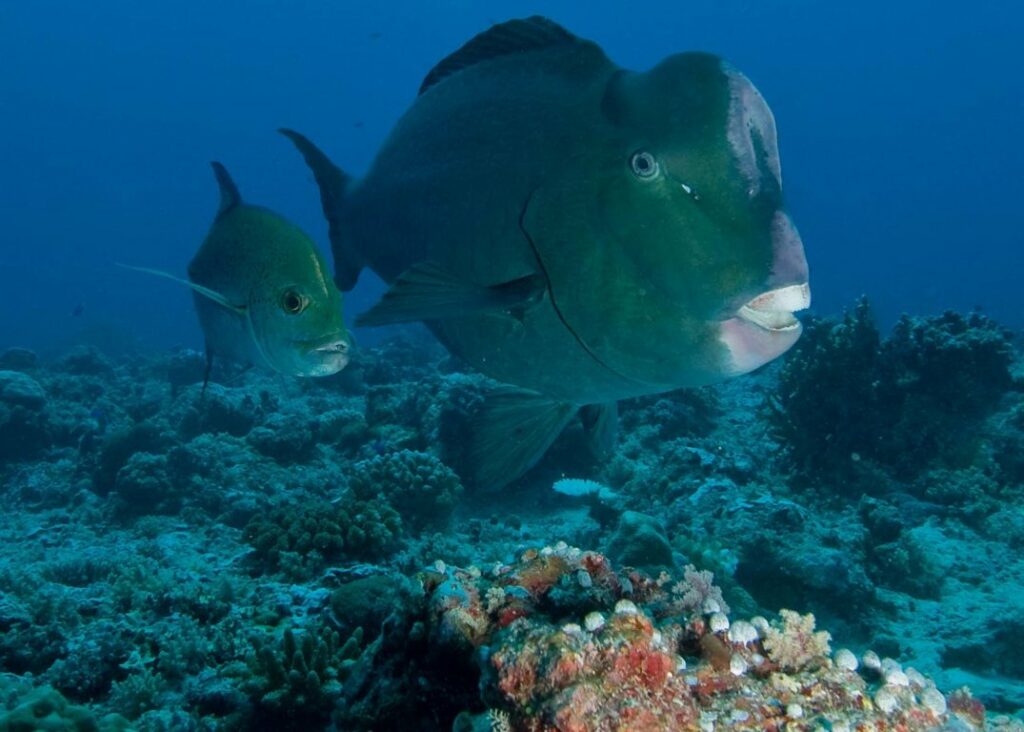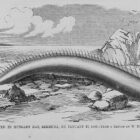Why does the Bumphead parrotfish ram its head into coral?

Sporting a massive hump on its forehead and a set of powerful jaws, the Bumphead Parrotfish (Bolbometopon muricatum) has intrigued scientists and underwater enthusiasts alike with its peculiar behavior of ramming its head into coral. Join me on a journey into the depths as we explore the mysteries behind the Bumphead Parrotfish’s coral headbutting ritual.
The Majesty of the Bumphead’s Headgear
The hump of the Bumphead Parrotfish is not a mere aesthetic appendage; rather, it is a testament to the evolutionary marvels shaped by the intricate dance of adaptation. This bony protuberance is a result of fused teeth, creating a sturdy and powerful structure that plays a pivotal role in the parrotfish’s daily activities.
From a functional perspective, the headgear serves as a highly specialized tool for the Bumphead Parrotfish’s herbivorous lifestyle. The fused teeth create a robust battering ram capable of withstanding the pressures exerted during the headbutting ritual against coral formations. This adaptation allows the parrotfish not only to break off chunks of hard coral for consumption but also to assert dominance and establish feeding territories.
The Bumphead Parrotfish’s Coral Ramming Ritual
Bumphead Parrotfish’s headbutting ritual is a sight to behold, as these marine giants position themselves in front of coral formations, preparing for a forceful collision. The characteristic crunching sounds reverberate underwater, echoing the powerful impact as the parrotfish employs its formidable headgear to break off portions of hard coral. But why does this herbivorous giant resort to such an extraordinary method of feeding?
At its core, the headbutting ritual is a culinary technique honed by evolution. The Bumphead Parrotfish’s unique headgear, consisting of fused teeth forming a robust hump on its forehead, is remarkably adapted for this purpose.
Hard corals that make up a significant portion of their diet require specialized tools for extraction. The Bumphead’s head serves as a battering ram, allowing it to dislodge chunks of coral, exposing the soft polyps within, which constitute the parrotfish’s primary source of sustenance.
Beyond the functional aspect of feeding, the headbutting ritual also holds significance in the realm of social dynamics and territorial behavior. As the Bumphead Parrotfish establishes feeding territories within the coral reef, the headbutting serves as a display of dominance. The distinctive crunching sounds act as an acoustic proclamation of the Bumphead’s presence, deterring potential competitors and asserting its claim over a specific area of the reef.
Coral Feeding: A Delicate Culinary Art
The Bumphead Parrotfish, equipped with a massive and robust headgear formed by fused teeth, engages in a culinary technique that involves breaking off chunks of hard corals. The specialized dentition, resembling a formidable beak, is not just an imposing physical feature but a tool finely tuned for the demands of their herbivorous diet.
As the Bumphead Parrotfish approaches a coral colony, the powerful jaws and fused teeth come into play. The parrotfish locks onto a piece of coral with its beak, delivering a forceful headbutt to fracture and detach the desired morsel. This process, accompanied by audible grinding sounds underwater, has earned the Bumphead Parrotfish the moniker “chainsaw of the reef”.
The choice of hard corals as a primary food source is not arbitrary. Hard corals, also known as stony corals, provide the Bumphead Parrotfish with essential nutrients and energy. The polyps within the coral exoskeleton contain algae that engage in photosynthesis, producing sugars that serve as a nutritional source for the parrotfish. By incorporating corals into their diet, Bumphead Parrotfish play a critical role in regulating coral growth and maintaining a balance within reef ecosystems.
While this feeding behavior may seem destructive, it is important to note that coral reefs have evolved with the presence of herbivores like the Bumphead Parrotfish. The constant grazing and selective feeding help control the growth of fast-growing coral species, preventing them from outcompeting slower-growing but structurally important corals. This delicate balance contributes to the overall health and resilience of coral reef ecosystems.
Territory Maintenance and Display of Dominance
Within the crowded and competitive underwater landscapes of coral reefs, space is a precious commodity. Bumphead Parrotfish, recognizing the significance of well-defined territories, engage in headbutting rituals as a means of establishing and reinforcing their claim over specific areas of the reef. The forceful impacts against the coral create distinct feeding zones, each marked by the Bumphead’s powerful presence and distinctive crunching sounds.
The headbutting serves as a form of communication among Bumphead Parrotfish individuals, with the audible reverberations acting as a proclamation of dominance. These acoustic signals convey vital information about the size, strength, and territorial boundaries of the parrotfish, enabling neighboring individuals to gauge the level of competition and avoid unnecessary conflicts.
Dominance within the Bumphead Parrotfish community is not solely determined by physical prowess but also by the size and health of the headgear. Individuals with larger and more prominent bumps are often perceived as more formidable and dominant. The headbutting rituals, therefore, become not only a display of physical strength but also a visual and auditory demonstration of hierarchical status within the group.
Violent Head-Butting Discovered in Giant Reef Fish










